Best Binoculars for Birding: A Complete Buying Guide
Right folks, let’s talk bins! Ever stared at a display of binoculars feeling baffled and overwhelmed? You’re not alone. The first and most important thing to get your head around is the numbering system used with binoculars. You’ve probably seen numbers like 8×42 and 10×42. Let’s begin with what those numbers mean.

Magnification
The first number you see is the magnification level – usually 8x, 10x, or 12x. If your immediate thought is “I’ll just go for the highest number,” well, hold your horses. Higher isn’t always better.
As magnification goes up, so does the weight and the price tag. But the real trade-off is stability. High magnification exaggerates every tiny twitch of your hands, making the image jittery, and it narrows your “Field of View” (how much of the scene you can see at once).
It’s a balancing act. For the record, Sara and I both use 10x, as we find it strikes the best balance for general birding in Ontario. Here is a quick breakdown to help you choose:
| Magnification | Best Used For | The Trade-Off |
|---|---|---|
| 8x | Woodlands & Warblers. Ideal for tracking fast-moving birds in trees. Gives you a wide, bright view and a very stable image. | You might struggle to see fine details on ducks or raptors that are far away. |
| 10x | The All-Rounder. A solid middle ground. Great for shorebirds, waterfowl, and general hiking. | Slightly heavier and a narrower field of view than the 8x. |
| 12x | Long Distance. Good for scanning lakes for waterfowl or watching distant hawks. | Heavy. The image will likely be shaky without a tripod or very steady hands. |
Objective Lens
The second number (like the 42 in 8×42) is your objective lens size in millimeters. The size of the lens at the far end of the binoculars. Think of this as the “light bucket.” The larger that glass is, the more light gets shovelled into your eyes. This is massive when you are birding in the dim light of dawn, dusk, or under the heavy canopy of an Ontario forest.
Once again, there is a price and weight balance. Glass is heavy. Very heavy! High quality glass is also expensive. If you go for huge objective lenses, you’re going to feel that weight on your neck a lot more quickly – and slightly less weight in your bank account. Conversely, if you go too small, the image you see through the binoculars is going to be dimmer.
Most birders find that 42mm is the Goldilocks number when it comes to birding and birdwatching. And if you want to take our advice, we both use 10×42 binoculars.
Here’s how the sizes stack up in a table like before:
| Lens Size | Best Used For | The Trade-Off |
|---|---|---|
| 30mm – 32mm | The “Travel Light” Hiker. Fantastic for long, strenuous hikes or travel where weight is your enemy. | Low Light Performance. In deep forests or at dusk, the image will be dimmer and harder to see than with larger models. |
| 42mm | The Standard. This is what most birders use. Perfect balance of brightness and weight for almost any situation. | Average Weight. Heavier than compacts, but usually manageable with a good strap or harness. |
| 50mm+ | Owling & Stationary Viewing. Incredible brightness. Like having night-vision goggles at dusk. | The “Brick” Factor. Very heavy and bulky. Not fun to carry around your neck for 10km. |
Other Considerations
Magnification and objective lens are the two main considerations – the main headlines that you will see listed for any reputable pair of binoculars. There are other factors to take into account, which we will list below in roughly the order of importance. Click or tap to read more details.
Field of View (FOV)
This refers to the width of the landscape you can see through the binoculars. The more you can see, the easier it is to actually find your target. If you have a narrow FOV, you will spend ages scanning a tree trying to find where that warbler went, only for it to fly away before you lock on.
While magnification is the main factor here (generally, 8x offers a wider view than 10x), the lens design plays a huge role, too. Don’t assume all 8x42s are created equal. A cheaper 8×42 model with the exact same numbers feels like looking through a toilet roll tube. It is always worth checking the specific “Field of View” measurement in the specs before you buy.
Lens Coatings & Glass Quality
You can have the perfect magnification and ideal lens size, but if the glass itself is poor, you are in for a disappointment. High-quality glass is the “secret sauce” that makes the image sharp and bright rather than muddy. Better glass also minimizes the nasty stuff. You want to avoid vignetting (where the corners of the image look dark) and chromatic aberration (a fancy term for “fringing,” where weird purple or green halos appear).
Keep an eye out for buzzwords like “ED Glass”, “HD”, or “Fully Multi-Coated”. I won’t bore you with the optical physics in a beginner’s guide, but essentially, these features ensure the image is crisp and colour-accurate.
Weather Sealing & Fog-Proofing (Non-Negotiable)
Let’s be honest: this is Ontario. You will get caught in the rain. If a pair of binoculars isn’t waterproof (or “weather-sealed”), put them back on the shelf immediately.
You also need to check for fog resistance (often listed as “nitrogen purged”). This stops moisture from getting inside and clouding up the glass during humid summers or drastic temperature changes – like stepping out of a toasty car into the frozen winter air. If your lenses fog up or water gets inside and you miss the ID on a fleeting Cerulean Warbler, can you really count it on your life list?
Eye Relief
If you wear glasses, you’ll want around 15mm of eye relief – the distance your eye can be from the binoculars and still see the full image. If there isn’t enough eye relief, it will be like looking through a keyhole (the edges of the image won’t be visible and the image will be tiny). Any decent binoculars will have adjustable eye relief with twistable eye-cups.
Close Focus
How close you can stand to an object and have the binoculars capable of focusing. If you graduate onto butterflies and other insects, you want to be able to get reasonably close to them and be able to focus. Anything over 6-7 feet is suboptimal. 6 feet or less is good.
Construction Quality & Warranty
Birding is an outdoor sport, and out here, things get rough. Look for binoculars with rubber armouring – that grippy, shock-absorbing coating that protects the glass when it inevitably swings into a tree trunk or slips from your winter gloved hands.
Check the warranty. This is where you need to read the fine print. There are two types of warranties.
- No-Fault (The “Clumsy” Warranty): Brands like Vortex and Athlon offer unconditional warranties. No receipt needed. If you drop them face-first onto the Canadian Shield and smash the lenses, they send you a new pair. This can be a near-priceless peace of mind.
- Defect Only: Other brands have warranties that cover you if they made a manufacturing mistake (e.g. Nikon). Some have limited time warranties (e.g. Zeiss has a 5 year warranty).
Our Recommendations
Generally speaking, you will want to stretch towards the very best binoculars that you can afford so that you don’t end up disappointed and wishing you’d aimed a bit higher (and end up buying a second pair). We will give some specific recommendations shortly, but we highly recommend purchasing from an established, reputable brand. In North America, those would include Nikon, Swarovski, Zeiss, Vortex, Athlon, Kowa, Leica, and Celestron. We recommend you avoid brands sold by large department stores like Canadian Tire, Target, Walmart etc…
Best Budget/Beginner Options
1st Place: Nikon Prostaff P7 10×42
Price: $200-$250CAD
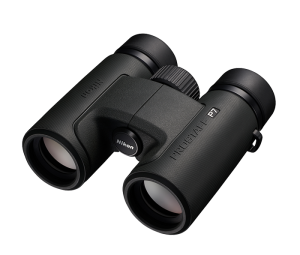
Pros: Good price for excellent glass. The king of entry-level binoculars. The typical bright image and wide field of view that you can expect from Nikon binoculars (but not as wide as their more expensive models). Reasonably lightweight.
Cons: Warranty only applies to factory defects – if you break these, you’ll have to buy new ones. Slightly cheap build feel (polycarbonate). Close focus is not close (10 feet is pretty poor).
2nd Place: Vortex Diamondback HD 10×42
Price: $330-$380 CAD
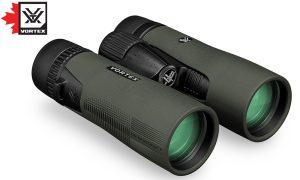
Pros: Rugged magnesium build, compact and they come with that lifetime warranty that covers accidental damage without the need for a receipt. Very good close focus (about 5 feet) if you like to look at other stuff like butterflies, plants or dragonflies..
Cons: Quite a bit more expensive and you may need to shop around to find the lower price point we mentioned above. Glass is not as good as the Prostaff P7 (more fringing and slightly duller) and the field of view is noticeably smaller.
Note: If you are on an even tighter budget, you could consider the above recommendations in the 8×42 format. You would be sacrificing some magnification for savings of around $50. You could opt for Bushnell or Celestron budget models, but we wouldn’t recommend the drop in optics quality.
Best Mid-Range (The ones we use!)
Stu’s Choice: Nikon Monarch 7 10×42
Price Stu Paid: $649 CAD
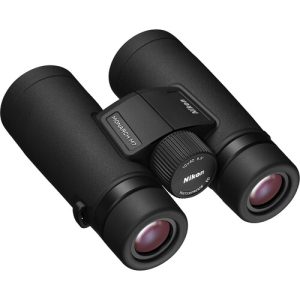
Pros: The major advantage is the field of view, which is excellent on Nikons, significantly out-performing the Vortex Viper HDs listed below. Compared to the budget Nikon Prostaffs, the glass quality is much improved. The coatings and ED glass significantly reduce fringing, increase brightness and the image is sharp to the edges. The glass slightly outperforms the Vortex Viper HDs. Has a locking diopter (right-eye focus can lock).
Cons: No accidental damage warranty. Stu dropped his pair and the right eye-piece would no longer focus. He had to buy a second pair, essentially doubling the price. Ouch. Built using polycarbonate and feel less rugged than the Vortex Vipers (but more premium than the Prostaffs). Close focus is 8ft – better than the Prostaffs, but not very good compared to the Vipers below.
Sara’s Choice: Vortex Viper HD 10×42
Price Sara Paid: $699 CAD

Pros: Very rugged, tough magnesium build, these binoculars are tanks! Lifetime, transferable, no receipt required warranty. Sara’s Vipers took a whack and the eye-piece is loose. When Sara sends them in, they will be repaired/replaced for free. If there is a chance you may break your binoculars, the Vortex Vipers will be essentially half the price. The close focus is a quite impressive 6.5ft.
Cons: A little bit of fringing when looking at high contrast areas with straight lines (like tree branches, fences) and marginally less bright. Field of view is significantly smaller compared to the Monarchs (about 12% less total image area).
Best Dream Binoculars
If money is no object, then look no further than brands like Zeiss and Swarovski. Like any expensive hobby, the returns are diminishing. The extra $4000 you are spending compared to the mid-range binoculars we use buys you some extra sharpness and brightness.
1st Place: Zeiss Victory SF 10×42
Price: $4999 CAD
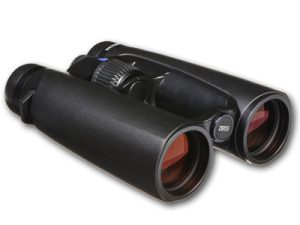
Pros: Just absolutely stunning edge-to-edge sharpness and a slightly brighter image than the Swarovskis below. Handles glare a little better, too. Focusing feels slightly more responsive. Zeiss binoculars come with a 5-year no-fault warranty. Field of view is good at 360ft/1000 yards, but could be better (slightly smaller than the Monarchs at 362ft – but Nikon excels at this). Close focus of 5ft – it doesn’t get better than this.
Cons: Faultless except the the price?
2nd Place: Swarovski NL Pure 10×42
Price: $4600 CAD
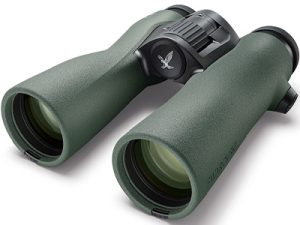
Pros: Almost matches the Zeiss, plus they have a stunning field of view at 399ft at 1000 yards and the lack of any black border mean they are incredibly immersive…. but…..
Cons: To achieve the above, you get a slight “convex” sensation, especially when panning across a landscape. A kind of glass ball affect. Some people get used to this in the NL and EL Swarovski models, others may find it disorienting. Warranty only covers defects, so you better not drop these the first time you see a Resplendent Quetzal.
Bonus Best For Young Birders Recommendations
We love that a lot of families with kids watch our videos, so we thought we’d recommend some binoculars for kids!
Note: Check if your child is able to use adult binoculars – children under the age of about 10 or children with narrower faces may not be able to fold down adult binoculars enough to see through both eye-pieces (their eyes may be narrower than the binoculars).
Elder Kids/Teens: Celestron Nature DX 8×42
Price: $190 – $210 CAD
Summary: These are light binoculars that give an adult-quality view that surpasses any kind of “toy binoculars”. The focus wheel moves nicely, for relatively easy focusing. These binoculars will fold to 56″ (standard for roof prism binoculars), so please check that your child can effectively see through them before purchase.
Budget Alternative: Nikon Trailblazer ATB 8×25 – $110-$130 | These have dual hinges and smaller barrels that may be easier to position for younger birders (still check if your young birder can use them). The trade-off is that the image will be darker.
Younger Birders aged around 7+: Opticron Savanna WP 8×30
Price: $170 – $190 CAD
Summary: Most binoculars these days use a roof prism, with a design limitation that they can only fold down to about 56mm – too wide for young birders. The Savannas are Porro Prism binoculars that can fold to 50mm. They are light at 17oz, waterproof, and durable. Decent eye-relief for glasses wearers. These are still sold as adult binoculars, so your young birder will need some maturity, enthusiasm and patience when learning to use these (they’re not toys).
Oberwerk 6.5×32 LW are a budget alternative ($130CAD) with less zoom that may make them easier to use, but they are harder to find in stores.
Toy Binoculars That Aren’t Terrible
Most toy binoculars use plastic lenses that have very poor image quality that will likely end up in landfill and put your child off birding – avoid them. But you could try Think Peak 8×21 binoculars that use glass lenses and rubber casing, making them durable.

Because the objective lenses are only 21mm, they can fold down to 35mm – this should be narrow enough to fit the faces of even very young birders.
